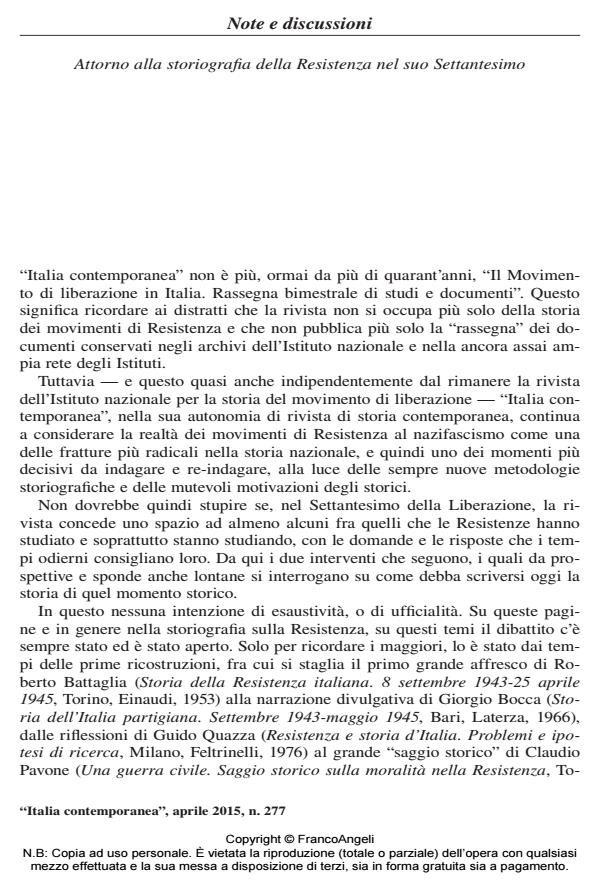On the historiography of the Italian Resistance by its seventieth anniversary
Journal title ITALIA CONTEMPORANEA
Author/s Philip Cooke, Luca Baldissara
Publishing Year 2015 Issue 2015/277
Language Italian Pages 36 P. 121-156 File size 238 KB
DOI 10.3280/IC2015-277005
DOI is like a bar code for intellectual property: to have more infomation
click here
Below, you can see the article first page
If you want to buy this article in PDF format, you can do it, following the instructions to buy download credits

FrancoAngeli is member of Publishers International Linking Association, Inc (PILA), a not-for-profit association which run the CrossRef service enabling links to and from online scholarly content.
Philip Cooke (Past, present and future of the historiography on the Italian Resistance) makes the point on the relevant scientific research, envisaging new possible approaches connected with the interpretative fulcrum of Claudio Pavone’s fundamental work A civil war, namely the topic of the "three wars". While the studies on the Liberation struggle have recently capitalised from the running research vein of massacres, which has fostered a better comprehension of the period by the key concept of "war against civilians", we should now try to gain a deeper insight into the so far overlooked topics of "civil war" and "class war", developing research on the perceptions and conditions of subjects not directly involved in the civil warfare, thereby drawing a more detailed picture of the social history of Italy during the conflict. Further, the extension of the Resistance chronology beyond April 25th, accomplished through the studies on post-war violence and memory, should encourage works aimed at reconstructing the Resistance legacy also at international level.
Luca Baldissara (Rethinking the history of the Resistance) surveys the studies over the 1943- 1945 events, individuating stages and features marked by the combinaton of historiographical framing with civil dimension: the 1945-1975 period, characterised by research on the extent to which the programs and aspirations of the resistants had been turned into reality in post-war Italy; the successive twenty years, during which the Resistance appears on the verge of being recognised as the crucial reference value for the Country, while there takes place an intense haul of research in parallel with a widening of its scope. On the eve of the Fiftieth recurrence, the advent of the "second Republic" brings into play a revision of the public discourse over the Resistance, centred on the "victimary paradigm" and on an anti-fascist memory revisited in terms of post-communist anti-totalitarianism. Yet new works broaden the investigation spectrum from the military to the civilian setting, individuating a specific form of counter-guerrilla and control of the territory practiced by the occupier, the "war against civilians", that alters the traditional context of partisan resistance. The A. signalises for the future three distinct research paths among others: the experience courses of the months and years prior to 1943 that lead the single persons to the decision to take up arms; the conduct of the war that fosters in the population an extensive "resistance to war"; the shadowy zones of the partisan warfare.
Keywords: "Three wars", "war against civilians", public discourse over the Resistance, historiography of the Italian Resistance, "victimary paradigm", "resistance to war"
Philip Cooke, Luca Baldissara, Attorno alla storiografia della Resistenza nel suo Settantesimo in "ITALIA CONTEMPORANEA" 277/2015, pp 121-156, DOI: 10.3280/IC2015-277005